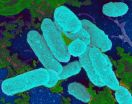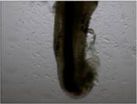(Press-News.org) A neuroscientist at Rutgers University-Newark says the human brain operates much the same whether active or at rest – a finding that could provide a better understanding of schizophrenia, bipolar disorder and other serious mental health conditions that afflict an estimated 13.6 million Americans.
In newly published research in the journal Neuron, Michael Cole, an assistant professor at the Center for Molecular and Behavioral Neuroscience, determined that the underlying brain architecture of a person at rest is basically the same as that of a person performing a variety of tasks.
This is important to the study of mental illness, says Cole, who made the discovery using functional magnetic resonance imaging (fMRI), because it is easier to analyze a brain at rest.
"We can now observe people relaxing in the scanner and be confident that what we see is there all the time," says Cole, who feared that his team might find that the brain reorganizes itself for every task. "If that had been the case, we would have had less hope that we could understand mental illness in our lifetime."
Instead, Cole says, scientists can now make their search for causes of mental illness more focused – and he suggests at least one target of opportunity. The prefrontal cortex is a portion of the brain involved in high level thinking, as well as remembering what a person's goal is and the task being performed.
Cole says it would be useful to explore whether connectivity between the prefrontal cortex and other areas of the brain is altered – while the brain is at rest – in people with severe mental illness. "And then we can finally say something fundamental," he predicts, "about what's different about the brain's functional network in schizophrenia and other conditions."
Those differences, in turn, could explain certain symptoms. For instance, what if a patient has visual hallucinations because poor connectivity between the prefrontal cortex and the portion of the brain that governs sight causes the hallucinations to override what the eyes actually see? Cole suggests that's just one of the questions that analysis of the brain at rest might help to answer. Others include a person's debilitating beliefs, such as overly negative self-assessment when depressed.
Opportunities to find better ways to improve patients' lives might then follow. Cole notes that current medications for severe mental illness, when they help at all, typically do not relieve cognitive symptoms. It is possible the drugs will reduce hallucinations or depressing thoughts, but patients continue to have difficulty concentrating on the task at hand, and often find it hard to find or hold a job. Cole says that even solving that one issue would be a major step forward – and he hopes his new work has helped advance science toward achieving this goal.
INFORMATION: END
Working to loosen the grip of severe mental illness
Consistent patterns in the brain found by a Rutgers researcher may accelerate the search for answers
2014-07-10
ELSE PRESS RELEASES FROM THIS DATE:
How antioxidants can accelerate cancers, and why they don't protect against them
2014-07-10
Cold Spring Harbor, NY – For decades, health-conscious people around the globe have taken antioxidant supplements and eaten foods rich in antioxidants, figuring this was one of the paths to good health and a long life.
Yet clinical trials of antioxidant supplements have repeatedly dashed the hopes of consumers who take them hoping to reduce their cancer risk. Virtually all such trials have failed to show any protective effect against cancer. In fact, in several trials antioxidant supplementation has been linked with increased rates of certain cancers. In one trial, ...
Depressed men with prostate cancer are diagnosed later stage, get less effective therapies
2014-07-10
Depressed men with localized prostate cancer were more likely to be diagnosed with more aggressive prostate cancer, received less effective treatments and survived for shorter times than prostate cancer patients who were not depressed, a UCLA study has found.
The negative outcomes may be the result of several factors such as bias against the mentally ill, depression's impact on biological cancer processes, the depressed man's lack of investment in his general health and disinterest in receiving more effective care, and missed opportunities by physicians to educate patients ...
Scientist finds link between antibiotics, bacterial biofilms and chronic infections
2014-07-10
Researchers from the University of Southern California and the Oak Crest Institute of Science have discovered the link between antibiotics and bacterial biofilm formation leading to chronic lung, sinus and ear infections. The study results, published in the current issue of PLOS ONE, illustrate how bacterial biofilms can actually thrive, rather than decrease, when given low doses of antibiotics.
"This research addresses the long standing issues surrounding chronic ear infections and why some children experience repeated ear infections even after antibiotic treatment," ...
BMSCs with Nogo-66 receptor gene silencing for repair of spinal cord injury
2014-07-10
After central nervous system injury, the increase in Nogo protein is mediated by Nogo-66 receptor gene, leading to the collapse of growth cones and inhibiting the extension of neuronal neurites. Zhiyuan Li and his team, Heibei Xingtai People's Hospital, China used RNA interference to silence Nogo-66 receptor gene expression in bone marrow mesenchymal stem cells (BMSCs), blocked the inhibitory effect of Nogo protein, promoted the process growth of neurons differentiated by transplanted cells, improved the therapeutic effects and increased the success rate of BMSCs transplantation ...
Inhibition of NgR expression reduces apoptotic retinal ganglion cells in diabetes
2014-07-10
Activation of Nogo receptor (NgR) is an essential factor of nerve regeneration inhibition, neuronal atrophy and even apoptosis. Upregulation of NgR expression is an important cause of cell apoptosis and visual extinction in some diseases including glaucoma. Whether ganglion cell apoptosis is related to NgR gene expression in diabetes mellitus remains poorly understood. Dr. Xuezheng Liu and his team, Liaoning Medical University, China interfered NgR expression in the retinal ganglion cells of rats with diabetes mellitus and found that Rho kinase expression was obviously ...
Fusion protein of single-chain variable domain fragments and myasthenia gravis
2014-07-10
Single-chain variable domain fragment (scFv) 637 is an antigen-specific scFv of myasthenia gravis and it can bind to acetylcholine receptor in the residues 67-76 of α-subunit of acetylcholine receptor. Dr. Fanping Meng and his team, College of Medicine, Yanbian University in China conjugated scFv and human serum albumin genes and detected the fusion protein in Pichia pastoris. Results showed that the fusion protein bound to acetylcholine receptors in neuromuscular junction of human intercostal muscle and the inhibition rate of fusion protein binding to acetycholine ...
How does miR-21 promote the differentiation of hair follicle-derived NCSCs into SCs?
2014-07-10
Hair follicle-derived neural crest stem cells (NCSCs) can be induced to differentiate into Schwann cells (SCs). However, the underlying regulatory mechanism during cell differentiation remains poorly understood. Dr. Yuxin Ni and her team, Hospital of Stomatology, Jilin University, China isolated NCSCs from human hair follicle and induced them to differentiate into SCs. MicroRNA (miR-21) expression was gradually increased during the differentiation of NCSCs into SCs. After transfection with the miR-21 agonist (agomir-21), the differentiation capacity of NCSCs was increased. ...
The optimal mitomycin C concentration for intact peripheral nerve structure and function
2014-07-10
Recently, local scar adhesion after laminectomy always challenges the worldwide scholars engaged in spine surgery. Mitomycin C, a classical anti-tumor drug, has been attempted to be used to effectively inhibit scar adhesion after laminectomy and some encouraging outcomes have been achieved. However, there is evidence that mitomycin C has inherent toxicity and other side effects when it is locally used. Whether mitomycin C can influence peripheral nerve structure and function remains unclear. Dr. Tao Sui and his team, the First Affiliated Hospital of Nanjing Medical University, ...
New research: Fresh avocado enhances absorption of essential nutrients for healthy living
2014-07-10
IRVINE, Calif. (July 10, 2014) – Consuming a whole fresh avocado with either an orange-colored tomato sauce or raw carrots significantly enhanced provitamin A carotenoid (alpha- and beta-carotene) absorption and conversion of these carotenoids to an active form of vitamin A, according to new research (1) published in The Journal of Nutrition.
Vitamin A is involved in reproductive health and growth promotion; helps support healthy skin, immune function, and vision; and has antioxidant properties. Provitamin A carotenoids, like alpha- and beta-carotene, impart the orange ...
Invasion of yellow crazy ant in a Seychelles UNESCO palm forest: Threats and solutions
2014-07-10
The yellow crazy ant Anoplolepis gracilipes is ranked amongst the top 100 worst global invasive species and is responsible for catastrophic ecological impacts on islands. A new study published in the open access journal NeoBiota examines and assesses the effects and dangers of the introduction of the yellow crazy ant to the unique,endemic ecosystem of the mature palm forest of the Vallée de Mai, a UNESCO World Heritage Site, on the Seychelles.
The palm forest of Vallée de Mai is a unique ecosystem containing many endemic species, including the iconic coco de mer palm ...
LAST 30 PRESS RELEASES:
Groundbreaking mapping: how many ghost particles all the Milky Way’s stars send towards Earth
JBNU researchers propose hierarchical porous copper nanosheet-based triboelectric nanogenerators
A high-protein diet can defeat cholera infection
A more accurate way of calculating the value of a healthy year of life
What causes some people’s gut microbes to produce high alcohol levels?
Global study reveals widespread burning of plastic for heating and cooking
MIT study shows pills that communicate from the stomach could improve medication adherence
Searching for the centromere: diversity in pathways key for cell division
Behind nature’s blueprints
Researchers search for why some people’s gut microbes produce high alcohol levels
Researchers find promising new way to boost the immune response to cancer
Coffee as a staining agent substitute in electron microscopy
Revealing the diversity of olfactory receptors in hagfish and its implications for early vertebrate evolution
Development of an ultrasonic sensor capable of cuffless, non-invasive blood pressure measurement
Longer treatment with medications for opioid use disorder is associated with greater probability of survival
Strategy over morality can help conservation campaigns reduce ivory demand, research shows
Rising temperatures reshape microbial carbon cycling during animal carcass decomposition in water
Achieving ultra-low-power explosive jumps via locust bio-hybrid muscle actuators
Plant-derived phenolic acids revive the power of tetracycline against drug-resistant bacteria
Cooperation: A costly affair in bacterial social behaviour?
Viruses in wastewater: Silent drivers of pollution removal and antibiotic resistance
Sub-iethal water disinfection may accelerate the spread of antibiotic resistance
Three in four new Australian moms struggle with body image
Post-stroke injection protects the brain in preclinical study
Cardiovascular risk score predicts multiple eye diseases
Health: estimated one in ten British adults used or interested in GLP-1 medications for weight loss
Exercise to treat depression yields similar results to therapy
Whooping cough vaccination for pregnant women strengthens babies’ immune system
Dramatic decline in new cases of orphanhood in Uganda driven by HIV treatment and prevention programs
Stopping weight loss drugs linked to weight regain and reversal of heart health markers
[Press-News.org] Working to loosen the grip of severe mental illnessConsistent patterns in the brain found by a Rutgers researcher may accelerate the search for answers









